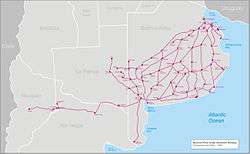Buenos Aires Great Southern Railway
| Buenos Aires Great Southern Railway | |||
|---|---|---|---|
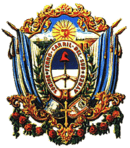 | |||
|
Constitución station in 1885. | |||
| Overview | |||
| Native name | Ferrocarril del Sud | ||
| Type | Inter-city | ||
| Status | Defunct company; rail line active | ||
| Locale |
Buenos Aires La Pampa Rio Negro Neuquén | ||
| Termini |
Buenos Aires C. de Patagones Zapala | ||
| Operation | |||
| Opened | 1862 | ||
| Closed | 1948 | ||
| Technical | |||
| Line length | 8,149 km (5,064 mi) | ||
| Track gauge | 1,676 mm (5 ft 6 in) | ||
| |||
The Buenos Aires Great Southern Railway (BAGS) (Spanish: Ferrocarril del Sud) was one of the Big Four broad gauge, 5 ft 6 in (1,676 mm), British-owned companies that built and operated railway networks in Argentina. The company was founded by Edward Lumb in 1862 and the first general manager was Edward Banfield after whom the Buenos Aires suburban station of Banfield was named, when it opened in 1873. After president Juan Perón nationalised the Argentine railway network in 1948 it became part of the state-owned company Ferrocarril General Roca.
History
Preliminary studies
The market of Plaza Constitución in Buenos Aires was attended by the carts coming from the South of the province that crossed the Riachuelo through the "Puente de Gálvez". Due to this transport was too costly, the products could not be carried on very long distances. In 1860, 7,416 carts with wool and leather had arrived to Constitución (each vehicle had a capacity of 25 packages 100 kg each).
About the passenger transport the situation was pretty similar. The carriages made three trips per month to Lobos, Cañuelas, 25 de Mayo, Saladillo and Dolores, two trips per month to Tandil and Lobería and just one to Bahía Blanca. The carriages were accompanied by "cuarteadores", that helped to cross rivers and streams. There also were intermediate stops such as "La Botica", a pulpería in Lomas de Zamora of Greater Buenos Aires.
This transport had considerable disadvantages, so there was not roads in good conditions and the rivers obligated to passengers to stray dozens of kilometers from the path. The carriages covered an average of 80 km per day.
Because of the explained above, Plaza Constitución was the first option to build a terminus station of a great railway that connected the city of Buenos Aires with the south of the province.
First steps of the railway
.jpg)
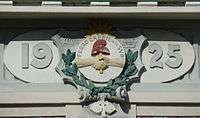
In August, 1861, Edward Lumb, a British entrepreneur, requested the concession of a railway line that would run from Constitución to the city of Chascomús, 120 km from Buenos Aires. Lumb offered $ 1,000,000 as guarantee to the Government of Buenos Aires. The initiative of Mr. Lumb was debated in the Chamber of Deputies, where it was concluded that railroad was necessary for the development of the Argentina nation. Juan B. Alberdi stated "The railroad will join the Argentine Republic better than all the congresses... without the 'iron road' that connects their extremes, the country will be always divisible and divided against all the Legislative decrees".
Finally, on 27 May 1862, the Buenos Aires Legislature promulgated the Law that authorized President of Argentina, Bartolomé Mitre, to deal a contract with Edward Lumb. The Government demanded an interest rate of 7% on the costs of construction, during 40 years. On the other hand, the company was exempt of paying contributions, taxes and custom fees. The railway company had also to carry the post for free. The Government could expropriate the railway and its assets if the company did not plus a 20% as compensation. The rail gauge should be the same than Buenos Aires Western Railway's and the company was able to build a tram line to Monserrat or any other strategic point of the city of Buenos Aires. The contract was officialized by the Government of Argentina on June 12, 1862.
On November 12 the railroad route was approved, according to the maps proposed by the concessionary. The Government wanted the railway crossed San Vicente but the lands were not in condition to build a line so the route was moved to La Paz (current Lomas de Zamora), where the field was more solid to extend the tracks. The route would extend from La Paz to Samborombón.
Lumb tried to get money in Buenos Aires to finance the construction of the railroad, but his attempts were not successful. As a result, he traveled to London, where bankers Baring and David Robertson agreed to give the company a credit to finance the construction of the railroad. The Ltd. company Buenos Aires Great Southern Railway was established, whose statutes were approved in 1863. The company requested Samuel Petro & E. Ladd to take over the construction of the whole railroad, including lands, stations, workshops and rolling stock at a cost of GBP 651,000. For GBP 14,000 the company hired Ing. Thomas Rumball for the supervision of the works.
When the works were about to begin, William Wheelwright (owner of Central Argentine Railway) tried to boycott the works of BAGSR due to that refused to cooperate with the other British companies that built competitive railways. He also stated that the BAGSR had obtained more benefits than his own company (CAR) to build the line. The Governor of Buenos Aires denied to sign a contract until the issue was solved. Finally Robertson paid bribes for GBP 22,000. The terms of the new contract determined that the line would be extended to Dolores and Azul.
Construction

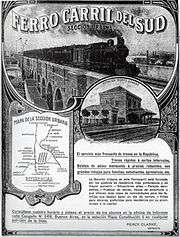
On March 7, 1864, works began where the Constitución railway station is placed nowadays. Previously, a big celebration had been held, with a ceremony attended by President of Argentina Bartolomé Mitre and Governor of Buenos Aires Province, Mariano Saavedra.
The first section of the railroad (77 km from Buenos Aires to Jeppener) was inaugurated on August 14, 1865. By December it had been extended to Chascomús (113 km). A total of 11 estaciones were built on this path: Plaza Constitución, Barracas al Sud (current Avellaneda), Lomas de Zamora, Glew, San Vicente (current Alejandro Korn), Domselaar, Ferrari (then Coronel Brandsen), Jeppener, Facio (then Altamirano), Gándara and Chascomús.
The rolling stock was composed by 8 locomotives (manufactured by Robert Stephenson and Company), 38 first and second class wagons,[1] by Brown, Marshalls and Co. Ltd. and 184 wagons for freight transport.
The line was single track with the exception of the path between Constitución and Barracas, where a double track was built to facilitate the transit of the trains due to the workshops and rolling stock depots operated in Barracas.
As time passed, some station were added, such as Barracas al Norte (current Hipólito Yrigoyen, 1866), Burzaco (1867) and Lanús (1868). The Great Southern Railway did not extend their tracks until 1870 but the profits increased year after year. In 1870 the line carried 516,993 passenger and 54,116 tonnes of freight.
| Year | Km | Passengers | Tonns of freight |
|---|---|---|---|
| 1866 | 114 | 193.608 | 14.439 |
| 1867 | 114 | 363.705 | 23.636 |
| 1868 | 114 | 423.834 | 32.376 |
| 1869 | 114 | 521.991 | 47.184 |
The bridge over the Riachuelo

The first serious obstacle that the engineers found was the Riachuelo, a stream that defines the southern boundary of the Buenos Aires federal district. It was necessary to build a double bridge (because of the double track that ran between Constitución to Barracas) to cross the stream. For that purpose, three iron cylinders were placed in both sides of the stream, filling them with concrete. The bridges were placed on those cylinders.[2]
The first bridge built by the BAGSR over the Riachuelo lasted 44 years, so in 1909 it was replaced by a moveable bridge that operated until 1982, when the line was electrified and a new bridge (built in concrete) replaced the old iron structure.[2]
Expansion to Dolores and Azul
By 1880 the GSR line reached 562 km built. The contract of concession ruled that the line should be extended to Dolores or any city determined by the National Government. The company built a branch from Altamirano to Río Salado (current General Belgrano Partido) in 1871. One year later the line extended to Las Flores and finally reached the city of Azul in 1876.
Some of the stations built were Ranchos, Villanueva, Bonnement, Salado, Chas, San Pedro (then Newton), Rosas, Las Flores, Colorado (then Dr. D. Harosteguy), Pardo, Cacharí, Parish, Pinedo and Azul.
The branch to Chascomús was extended to Dolores (opening this new section in 1874). The new stations built were Monasterio, Lezama, Guerrero, Taillade (current Castelli), Sevigné and Dolores (km 203).
The urban section of Buenos Aires
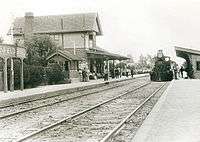
The original Lomas de Zamora station building was demolished at the beginning of the 1870s to build a more modern structure there. The new stations built were: Temperley (1871), Adrogué (1872) and Banfield (1873). Temperley was then a small town with small farms extended from Lanús to Burzaco. The nearest station was Lomas de Zamora where some houses stood alongside the main road (today Pavón Avenue).
Jorge Temperley, who owned many lands in that place, showed his interest to build a train stop for which he donated the field where the station would be built. Therefore, in 1871 the primitive Temperley station was inaugurated. The station would be moved some years later to its current location.
In 1877 the BAGSR built new warehouses for the freight trains in Constitución station, also acquiring lands to build the freight station (Solá, in Buenos Aires). The company also increased the capacity of the Barracas al Sud station's warehouses. The same year all the tracks were removed and replaced. The double track also extended from Barracas to Altamirano.
The train reaches Tandil
In 1871 the company began to expand their net, through two main branches. The first extended from Altamirano to Azul (connecting cities as Ranchos and Las Flores) and the other branch from Chascomús to Dolores and Ayacucho (inaugurated in 1880).
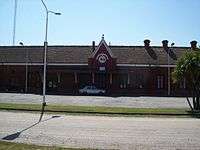
Some rumours referred to a possible expropriation of the company by the Government of Buenos Aires. Because of that, the company directory sent Frank Parish and C.O. Barker (President and Secretary of the company, respectively) to Buenos Aires with the purpose to deal with the Government to avoid cancellation of the concession. The parties finally make an agreement that established BAGSR compromise to build two extensions of the line: one from Azul to Bahía Blanca and the second from Ayacucho to Tandil. The contract signed on October 1881 ruled that the train would reach the city of Tandil within the three subsequent years.
The prolongation of the line from Ayacucho began in 1882. The station was built on a land that had belonged to Mari Blas Dhers, acquired by the company for $200,000.
On May 6, 1883, the first train arrived to Tandil. On September 1 the definitive opening of the line was promulgated.[3]
Branches to Bahía Blanca
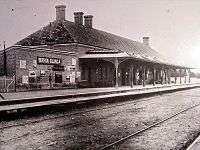
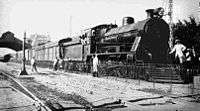
By 1884, many towns had been founded in Buenos Aires Province. Some of them were Azul (established 1832), Esperanza (now General Alvear, 1854), Las Flores and 25 de Mayo (both 1856), Tapalqué (1863), Saladillo (1864), Arenales (then Ayacucho, 1866), Olavarría (1867) and Benito Juárez (1874).
Moving among those cities was a real odyssey. In most of cases the vehicle used was the "galera", a big carriage with capacity for many passengers. Those vehicles transport guns to repel malones and assaults, and could cover 80 km in a day.
In 1866 the Government of Argentina and the shipping company Aguirre y Murga signed a deal to establish a passenger and freight service between Buenos Aires, Bahía Blanca and Carmen de Patagones. The contract ruled that the company should make a monthly trip, being granted for its services.
The BAGSR extended the line to Olavarría, opening the service in March, 1883. The tracks continued their expansion, reaching General Lamadrid on October. Finally the line reached the city of Bahía Blanca in April 1884, opening the service to passengers on July 7. The travel from Buenos Aires to Bahía Blanca took 24 hours. By 1884 the BAGSR was the largest railroad of Argentina, with 1,025 km operating.
At the same time the line to Bahía Blanca was being built, the company made the arrangements to build a port in that city. The dock was made of steel and finished in 1885. It has 8 cranes, 5 tracks, a length of 300 meters and 200 meters width.[4]
The other branch, extended to Benito Juárez in 1885, reaching the city of Tres Arroyos in April 1886. The company was given approval to extend its tracks from Tres Arroyos to Bahía Blanca. The works were concluded in December 1891.
The Ensenada & Port railway

In 1866 the Buenos Aires and Ensenada Port Railway opened its services to public. The project was to build a new port to replace the Port of Buenos Aires but this project was cancelled and the port never built. The foundation of the city of La Plata in 1882 brought with it the construction of a new railroad with the terminus station in that city. The works were carried out by the Buenos Aires Western Railway, then owned by the Government of Buenos Aires. The construction of a new railroad limited the possibility of expansion of the BAEPR.
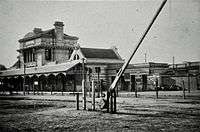
One of the branches built by the BAWR extended from Tolosa to Magdalena, acquired by the BAEPR in 1888. The company also tried to expand its business acquiring the Brandsen-Ringuelet branch. The BAEPR also built a line from Bartolomé Bavio (a small town near to Magdalena, at the South of Buenos Aires Province) to Álvarez Jonte, opened in 1892. The following year the branch extended to Atalaya, Magdalena Partido.
The fire that destroyed the Estación Central of Buenos Aires in 1897, obligated the BAEPR to move the terminus station to Casa Amarilla in La Boca district. As a result, the viaduct used by the BAEPR trains to run over Paseo Colón Avenue was no longer in use (being later dismantled). Therefore, the number of passengers carried by the company (and the profits) decreased considerably.
On July 1, 1898, the Buenos Aires and Ensenada Port Railway was acquired by the Great Southern Railway.
Workshops
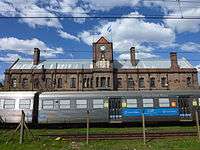
The railway's repair shops were originally located in Barracas al Sud station and then moved to Sola, where they operated for more than 15 years. The capacity of the workshops was surpassed due to the growth of the line. There was not enough place to enhance the workshop so the company managers considered the possibility of installing new facilities on some point of the line.
Therefore, the new workshops were built in 1901 at Remedios de Escalada, 11 km from the Plaza Constitución, were the largest in South America, and employed nearly 2,700 men. Although primarily for repair work, the shops were equipped to make every part of a locomotive or a railway carriage. When the company took over the working of the Bahía Blanca and North Western Railway from the Buenos Aires and Pacific Railway company in 1925 it acquired the latter's workshops in Bahia Blanca.
At the same time the workshops began their activities in Remedios de Escalada, the company draft a project to build houses for the employeers of the workshops. This housing complex was named "Colonia Ferroviaria"
By the end of the 1940s, the workshops of Escalada had become a sort of factories, where all type of components and spare parts for the locomotives and coaches were manufactured.
The train arrives to the Atlantic

On 26 September 1886, the first train arrived to the city of Mar del Plata, that was the main tourist destination during summer season.[5]
The BAGSR expanded its business on the Atlantic coast, building lines to other cities. In February 1892 the branch from Ayacucho to Balcarce was opened. On August the line extended to Quequén, a small town next to Necochea. Quequén had one of the main ports of the province.

In 1910 Mar del Plata was the main beach city of Argentina, receiving a huge number of tourists (most of them members of the aristocracy) during the summer. Due to the intense traffic of passengers, the railway station exceeded its capacity and the Municipality demanded the company to increase the facilities. The company had always denied to this request alleging that the station was only overcrowded during two months per year (the period of summer season in Argentina).
During the first decade of the 20th century, the urban development of Mar del Plata moved from the downtown to the South West (nearest to the coast) so the train station was far from the residences and hotels where the tourist were hosted. In June 1908, the Congress promulgated Law 5.535, authorizing the BAGSR to build a new station in Mar del Plata.

Although the construction of a new station had been approved, a neighbours committee (led by Mar del Plata pioneer Pedro Luro) opposed to the old station was demolished, requesting its preservation. Percy Clarke, manager of the company had to accept the neighbours' claim. The other point of conflict with the inhabitants of the city was the path of the new line. While the company wanted to build the new station near to the coast (to reduce costs), the neighbours demanded the station should be located far from the most populated areas of the city. Finally, the BAGSR agreed to build the new station where the neighbours demanded.
The works began in 1909 and were finished one year later, when the station building began to be constructed. The project of the company also included extension of the tracks to the city of Miramar. The new station in Mar del Plata (named "Mar del Plata Sur") was opened On December 1, 1910, although the main building was not still finished so a provisional wooden-structure was opened to the public for the 1910–11 summer season.
As the old station (renamed "Mar del Plata Norte") remained active, the new station would be only used during the summer seasons. It had two large platforms, the main building, a post warehouse, and a signal cabin. When the new station opened, all the trains that arrived to the old station were reprogrammed to make their arrival to the South station. It totalized four services per day, including the two express services. Nevertheless, a few days before the inauguration, the BAGSR requested the Government that only the express services arrived to the new station, due to the other three trains programmed had to end their routes in Miramar and could not change their path to the south station.
The request was approved and therefore only the express services stopped at the new station.
Expansion (1865–1899)
The expansion of the BAGSR since its inauguration until the 1890s was considerably high. Below are detailed some of the main cities reached by the railroad during this period.[6]
| Branch | Opened | Km |
|---|---|---|
| Buenos Aires to Jeppener | 14 Aug 1865 | 77 |
| Jeppener to Altamirano | 14 Dec 1865 | 10 |
| Altamirano to Chascomús | 14 Dec 1865 | 26 |
| Altamirano to Ranchos | 1 Mar 1871 | 24 |
| Ranchos to Gral. Belgrano | 19 May 1871 | 32 |
| General Belgrano to Las Flores | 1 Jul 1872 | 64 |
| Chascomús to Dolores | 10 Nov 1874 | 90 |
| Las Flores to Azul | 8 Sep 1876 | 109 |
| Dolores to Maipú | 7 Dec 1880 | 68 |
| Maipú to Ayacucho | 7 Dec 1880 | 62 |
| Azul to Olavarría | 15 Mar 1883 | 43 |
| Ayacucho to Tandil | 19 Aug 1883 | 63 |
| Olavarría to General La Madrid | 1 Oct 1883 | 93 |
| Gral. La Madrid to Bahía Blanca | 7 May de 1884 | 261 |
| Tandil to Benito Juárez | 8 May 1885 | 85 |
| B. Juárez to Tres Arroyos | 2 Apr 1886 | 89 |
| Maipú to Mar del Plata | 26 Sep 1886 | 129 |
| Merlo to Lobos | 21 Jun 1890 | 64 |
| Lobos to Saladillo | 21 Jul 1890 | 87 |
| Temperley to Cañuelas | 12 Mar 1890 | 47 |
| Las Flores to Tandil | 1 Aug 1891 | 151 |
| Tres Arroyos to Bahía Blanca | 2 Dec 1891 | 192 |
| Olavarría to Loma Negra | 21 Aug 1893 | 7 |
| Cañuelas to Las Flores | 1 May 1892 | 114 |
| Ayacucho a Balcarce | 24 Feb 1892 | 88 |
| Balcarce to Quequén | 1 Aug 1892 | 105 |
| Quequén to Necochea | 1 Aug 1892 | 2 |
| Cañuelas to Lobos | 1 Aug 1892 | 33 |
| Saladillo to General Alvear | 1 Nov 1897 | 48 |
| Lobos to Navarro | 1 Jan 1898 | 24 |
| Lobos to 25 de Mayo | 10 Jan 1898 | 108 |
| 25 de Mayo to Bolívar | 27 Jun 1898 | 124 |
| Bolívar to Guaminí | 27 Jul 1898 | 155 |
| Guaminí to Saavedra | 27 Jul 1898 | 134 |
| Choele Choel to Cipolletti | 1 Jun 1899 | 214 |
Since 1884 the BAGSR presented drafts to extend the tracks from Dolores to Mar de Ajó (atlantic coast of Buenos Aires Province) but this project would not be carried out.
In 1885 the Government granted Dávila y Compañía the construction of a tram line that departing from Olavarría station, ended in the San Jacinto quarry (operated by the same company). This line would be transferred by Dávila to the BAGSR in 1889 and opened to public in 1893.
In 1908 the branch from General Guido to Juancho (with a stop in General Madariaga) that finally reached Vivoratá in 1912. Other lines opened were Bosques-Berazategui, Neuquén-Zapala and Álvarez Jonte-Las Pipinas among others, totalizing 6,082 km until then.
Temperley station
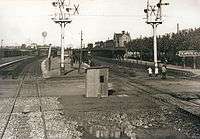
The foundation of the city of La Plata contributed to the development of the railroad system. The Buenos Aires Western Railway built a line from that city to Haedo, crossing the Province from South to West.
The managers of the BAGSR saw the opportunity to make a combination between both railways to connect the Constitución and La Plata stations and enter into competition with the Buenos Aires and Ensenada Port Railway that had a service to La Plata. The managers of Western Railway also showed their interest to connect both lines.
Therefore, in February 1884 a junction between José Mármol and Temperley station was opened. This junction allowed passengers and freight services to run between Constitución and La Plata. A new Temperley building station would be inaugurated in 1888.[7]
Extensions
In 1906 the BAGS proposed an extension of the line from Zapala, 115 km from the Chilean border, across the Andes to the town of Lonquimay in Chile. Due to lack of funds the line was never built.[8] This would have provided a rail link between the two countries in addition to the Transandine Railway, connecting Mendoza in Argentina with Los Andes in Chile, which was opened in 1910.
Other mainline services included those from Buenos Aires via Bolivar to Carhué, via Maipú to Tandil, via Chas and Ayacucho to Necochea, and services from Bahía Blanca to Toay in La Pampa Province and to Huinca Renanco in Córdoba Province.
Growth
By 1930 the company had become a great corporation, probably the largest in the region. Its assets included 8,000 km of tracks, 504 stations, 857 steam locomotives, 955 carriages, 16,602 coaches and more than 30,000 employees. The Ferrocarril del Sud also contributed to the development of several cities of Buenos Aires Province. The railway communicated the suburban areas with the Capital city, carrying agricultural products to the ports of Buenos Aires, Necochea and Bahía Blanca. The company and its subsidiaries also operated a fruit farm in Río Negro Province, an energy station in Bahía Blanca, the Club Hotel of La Ventana and another hotel in Miramar.
The company also built the Ingeniero White port and a dock with capacity for four steamships. Along with other British-owned railroad companies, BAGSR took part in the "Compañía Ferrocarriles de Petróleo" in Comodoro Rivadavia, where the companies were supplied fuel oil for their locomotives.
The BAGSR reached its peak during the last years of the 1920s. Nevertheless, the increase of costs, the devaluation of the Argentine Peso and the increasing in the road traffic, resulted in declining profits for the company.
After then president of Argentina Juan Domingo Perón signed the nationalization of the Argentine railways, the Buenos Aires Great Southern Railway was renamed "Ferrocarril General Roca".
Ports
Puerto Ingeniero White, one of ports of Bahía Blanca, was built by the company who installed two grain elevators there in 1908 to cope with the increasing grain traffic, and constructed a jetty to provide berthing for four steamships. Together with the other British-owned railways, the company had a financial interest in the Compañía Ferrocarriles de Petróleo in Comodoro Rivadavia whose wells supplied a large proportion of the fuel oil used by these railways. The railway controlled and operated the South Dock in Buenos Aires, at the mouth of the Riachuelo River.
Traffic
Much of the goods traffic, including the movement of grain, livestock, fruit from the valley of the Rio Negro, was seasonal, as was the summer tourist traffic to Mar del Plata, Miramar and Necochea. Apart from the suburban services around Buenos Aires and Bahía Blanca, the main traffic flow was between these two cities and beyond by three routes: the direct line via Las Flores, Olavarría and Coronel Pringles; a variant of this from Olavarría through General La Madrid and Saavedra; or finally via Las Flores and Tres Arroyos. Services beyond Bahia Blanca through the Plaza Huincul oilfield to Zapala in Neuquén Province, at first provided by through coaches on trains to Bahía Blanca, soon developed to the point where it became necessary to run separate complete trains from Buenos Aires.
Decline
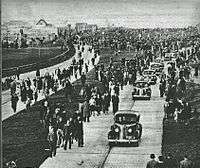
Between 1907 and 1914 the railroad companies in Argentina had extended their lines an average of 1,800 km per year (more than any European country in the same period), with a total extension of 33,000 km. When the World War I began, the "Golden Age" of Argentine railways ended. Between 1917 and 1922 only 100 km were built.
The British companies also had to deal with the increasing costs, the decrease of the international commerce and the workers syndicates. Marcelo T. de Alvear (elected President of Argentina in 1922) encouraged cooperation with the British companies, which recovered from the great post-war depression and increased their profits 5% per year since 1921 (and 9% since 1924).
Nevertheless, the great depression of the 1930s and a plan to build an extensive amount of roads for automobile transport (for which the Government created the "Dirección Nacional de Vialidad", an office in charge of the development, planning and conservation of national routes) created an extremely difficult climate for the British railway companies in Argentina.
The increase of the automobile transport caused the investments for the railroad companies decreased considerably. Cars competed with trains when many routes began to be built, some of them with pathways parallel to the railway tracks. The British companies were also facing increasing competition from transport on the expanding road network, with the plan carried out by the national Government to avoid the monopoly for transport on the railway companies.
Except during the 1939–45 war in Europe, most of the steam locomotives, almost all of which were manufactured in Britain, burned oil, a fuel in which Argentina was almost self-sufficient. Coal suitable for locomotive working was not available locally and had to be imported. The heaviest goods trains, reaching over 2000 tons during the harvest season, were often hauled by three-part articulated Garratt locomotives.
Nationalization
When the entire Argentine railway network was nationalised in 1948, during Juan Peron's presidency, the BAGS became part of the General Roca Railway, one of the six divisions of State-owned Ferrocarriles Argentinos. At the same time the Roca Railway absorbed the former state-owned Ferrocarriles Patagónicos that included line from Carmen de Patagones to Bariloche, the 750 mm (2 ft 5 1⁄2 in) narrow gauge line from Ingeniero Jacobacci to Esquel, affectionately known as La Trochita, and the southern half of the French-owned Rosario and Puerto Belgrano Railway.
See also
Bibliography
- D.S. Purdom, British Steam on the Pampas, Mechanical Engineering Publications Ltd, London, 1977
- William Rogind, Historia del Ferrocarril Sud 1861–1936, Editorial Ferrocarril Sud, Buenos Aires, 1937
- Colin M. Lewis, British Railways in Argentina 1857–1914: A Case Study of Foreign Investment, Athlone Press (for the Institute of Latin American Studies, University of London), 1983
References
- ↑ "Los coches del Ferrocarril del Sud" at Ferrocarriles del Sud blog
- 1 2 "Los puentes del Sud sobre el Riachuelo" on Rumbo al Sud Magazine (Archive)
- ↑ "Cuando el tren llegó a Tandil" - Rumbo al Sud website (Archive)
- ↑ "La Provincia de Buenos Aires: territorio" on Rumbo al Sud magazine (Archive)
- ↑ "Ferrocarril" at Mar del Plata Ayer website
- ↑ Ferrocarril Sud: Inauguración oficial de la Prolongación de Bahía Blanca al Neuquén, Buenos Aires, 1899
- ↑ "El despegue de la Estación Temperley" at Rumbo al Sud magazine (Archive)
- ↑ "Attempts to cross the border". Railways of the far south. Retrieved March 4, 2013.
| Wikimedia Commons has media related to BA Great Southern R.. |

